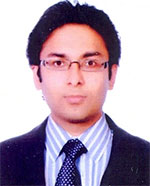Interview with Vimal Bhatia, Professor, IIT Indore


Vimal Bhatia is a Professor in the Discipline of Electrical Engineering at the Indian Institute of Technology Indore, India. He is also an associated faculty with Centre for Advanced Electronics and Discipline of Astronomy, Astrophysics, and Space Engineering at IIT Indore. He is also an adjunct faculty with IIT Delhi and IIIT Delhi. He completed his PhD from The University of Edinburgh in Adaptive Signal Processing after his Masters in Signal Processing from NSIT, Delhi. He has worked in various telecom/voice/audio/video processing companies both in India and the UK. His research interests are in the areas of beyond 5G, machine learning and sparse signal recovery techniques applied to wireless communications. He has authored/co-authored 108+ journal papers and 145+ conference papers. He was General Vice-Chair and General Chair for IEEE ANTS 2017 and IEEE ANTS 2018.
Q1. Please tell us a bit about your recent work in the area of signal processing.
Vimal: In the recent past, we have largely been working exploring adaptive and sparse signal processing algorithms for various applications in communications, radar and optics. Over the years, we have observed that practical systems be it for communications, radar or optics have their performance impaired due to non-ideal characteristics of a systems. In theory most algorithm and solutions are designed with an ideal system assumption. Hence, we embarked on a journey to find solutions using advanced signal processing techniques. We have been working on handling nonlinearity with user mobility while handling multiple users for ultra-dense network for visible light communications (VLC). We find that classical solutions based on polynomial expansion or with mean square cost function, generally fall short of ideal performance by a huge margin. Hence, we have designed solutions and proposed algorithms based on adaptive algorithms using reproducible kernel Hilbert space (RKHS) paradigm, which have been found to perform very well. Moreover, a post-distorter’s performance is measured in terms of their symbol or bit error rates, hence we find that the algorithms designed to have this in mind perform better than the conventional mean square error criterion based stochastic gradient algorithms.
We also recently observed that the clutter in radar systems also have non-ideal characteristics and algorithms designed with these assumptions in mind, do not perform estimation of a target’s Doppler shift and time-delay as accurately. By using RKHS based stochastic gradient algorithms, we get much closer to the theoretical lower bounds.
In one of our research projects on television white space, we find the channels are highly sparse. Hence for better channel estimator, we have proposed algorithms for active taps identification. We have also proposed channel estimators and spectrum sensing paradigms using Grassmann Manifold and non-parametric pdf estimation approach which work exceptionally well in interference limited communication channels. These algorithms have been demonstrated using NI USRP and GNU Radio. The demonstration has been at various forums including the National Conference on Communications 2017 at IIT Madras, India International Science Festival at IIT Delhi and Festival of Innovations at the Rashtrapati Bhavan (President’s House).
Another recent challenging work we have explored recently is on ultra-wide band communications transmitter and receiver design. This was particularly challenging since both the signal and the channel are sparse in nature. We designed algorithms using compressed sensing, and recently using deep learning frameworks for efficient symbol recovery.
As we initiate R&D towards 6G, our recent research focus has been on energy harvested wide bandwidth receivers with enhanced edge computing designed for ultra-low latency dense networks.
Q2. What challenges do you think our current student population faces as far as preparedness for a career in signal processing related research and development is concerned?
Vimal: In my opinion, these are very exciting times for a student to be working in signal processing. Signal processing is an extremely vast subject, for me as anything that contains information is a signal and we as engineers and scientists work with these signals for making better systems. Many of the classical statistical and adaptive signal processing algorithms have been extended and applied in present day buzzwords machine learning, and deep learning. Basic filter design, linear algebra, predictors, system identification, compression, noise cancellation etc supported by Fourier/Wavelet/Z-transforms concepts are still very relevant and are being applied in beyond 5G and 6G communications, biomedical devices, biometric and security, financial signal processing, defence, and even in agriculture for increasing yield.
In today’s world there are plenty of resources and visualization tools that did not exist in the past. There are also excellent online lectures which a student can access, and if this is topped by guidance from faculty/professionals and one-to-one discussions would help in circumventing any such challenges.
Q3. In your opinion, what are some of the exciting areas of research in signal processing for students and researchers?
Vimal: As I said before as a signal processing researcher the students can get into a variety of areas that they would be interested in, since signal processing is a very vast subject. There are many emerging areas and applications to work with, where the students and researchers would have the opportunity to modify or even come-up with new algorithms. There are many interesting problems in 5G/6G communications, visible light/ultra-violet communications, sparse signal processing for comms, radar, biomedical and agricultural applications. There are very many hard defence problems such as identification, tracking, interference and noise handling. Handling images, audio, video, and with recent advances in haptics is also an interesting challenge. Over the years we have seen high interest in drones and molecular-nano communications, biometric and other security applications. There are further interesting challenging areas in finding efficient, optimized and practically realizable algorithms that also need to work real-time and with low latency. All of the above could be mind boggling, one of the first places to explore as I would suggest is reading articles in IEEE Signal Processing Magazine, attending conferences, continuous education programs, short online tutorials etc. Wishing all the best to budding signal processing researchers.

